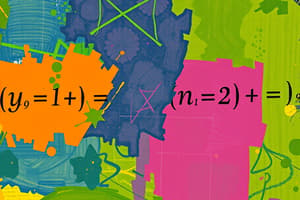Podcast
Questions and Answers
What is the result of distributing the expression 3(4x + 5)?
What is the result of distributing the expression 3(4x + 5)?
- 12x + 8
- 7x + 15
- 4x + 15
- 12x + 15 (correct)
What is the greatest common factor (GCD) of 15 and 25?
What is the greatest common factor (GCD) of 15 and 25?
- 15
- 1
- 75
- 5 (correct)
Which step is NOT part of determining if two expressions are equivalent?
Which step is NOT part of determining if two expressions are equivalent?
- Substituting values for the variable
- Finding the GCD of the coefficients (correct)
- Simplifying both expressions
- Comparing the simplified results
When factoring the expression 12 + 8, what is the correct factored form?
When factoring the expression 12 + 8, what is the correct factored form?
Using the order of operations, what is the result of the expression 3 + 2 * (7 - 4)?
Using the order of operations, what is the result of the expression 3 + 2 * (7 - 4)?
Flashcards
Distributive Property
Distributive Property
Distributing a number outside parentheses to each term inside, multiplying them.
Factoring Out a Common Factor
Factoring Out a Common Factor
Finding the greatest common factor (GCD) of numbers, placing it outside parentheses, and dividing each number by the GCD inside.
Equivalent Expressions
Equivalent Expressions
Expressions are equivalent if they simplify to the same value for any variable value. Follow PEMDAS/BODMAS: parentheses/brackets, exponents/orders, multiplication/division (left to right), addition/subtraction (left to right).
PEMDAS/BODMAS
PEMDAS/BODMAS
Signup and view all the flashcards
Checking for Equivalent Expressions
Checking for Equivalent Expressions
Signup and view all the flashcards
Study Notes
Generating Equivalent Expressions
- When a number is outside parentheses, distribute it to everything inside.
- The distributive property is used to multiply a number outside parentheses by each term inside.
- This can be represented by 2(r + 3) = 2r + 2(3) = 2r + 6
- Factoring out a common factor involves finding the greatest common factor (GCD) between two or more numbers.
- The GCD is then placed outside the parentheses, leaving the quotient of each number by the GCD inside.
- Example: 8 + 2, the GCD is 2. The factored form is 2( 8/2 + 2/2) = 2(4 + 1).
- To determine if expressions are equivalent, substitute different values for the variable and simplify both expressions.
- If the results are the same, the expressions are equivalent.
- When simplifying expressions, follow the order of operations (PEMDAS/BODMAS): parentheses/brackets, exponents/orders, multiplication and division (from left to right), addition and subtraction (from left to right).
Studying That Suits You
Use AI to generate personalized quizzes and flashcards to suit your learning preferences.




